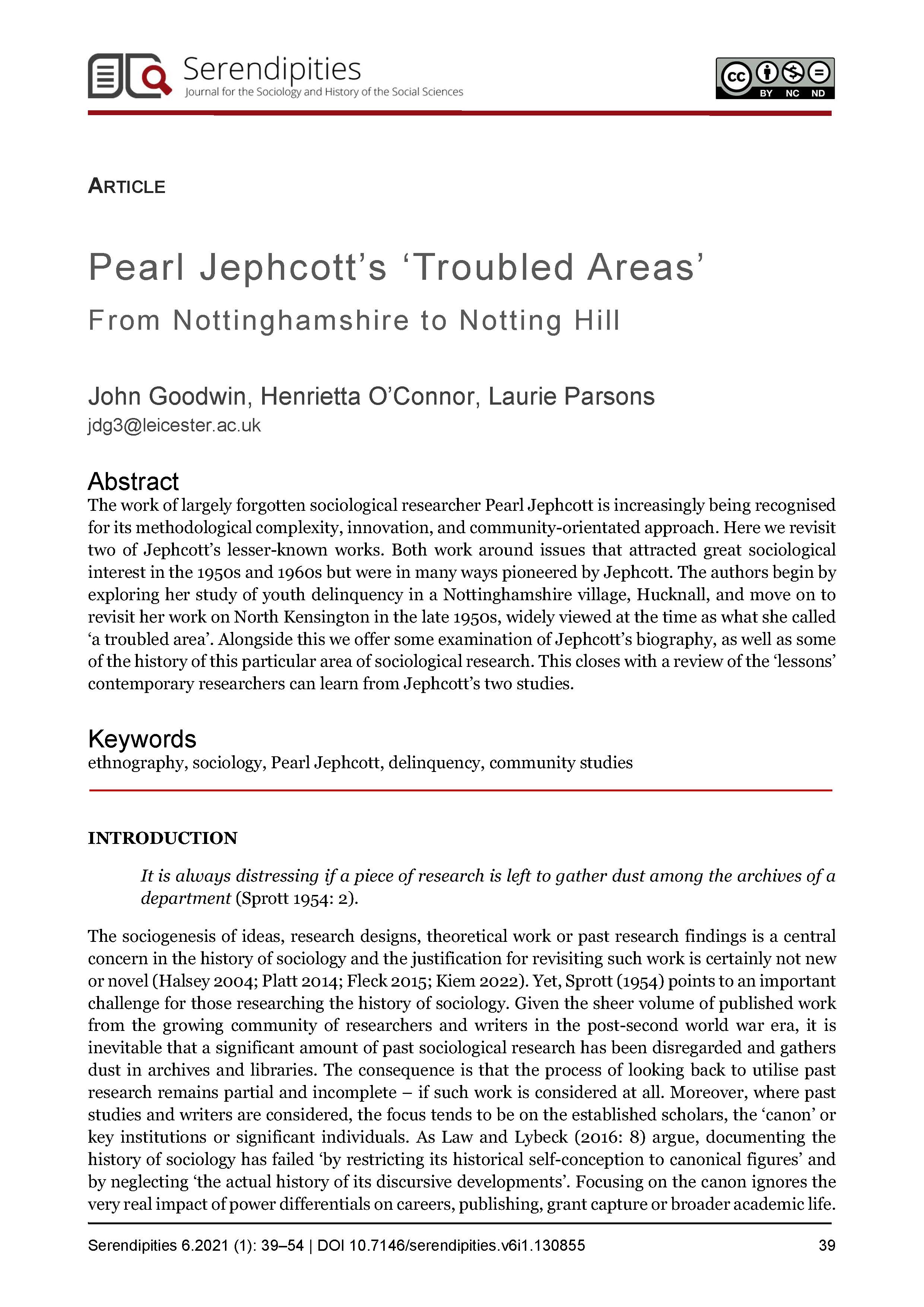From Nottinghamshire to Notting Hill: Contemporary Lessons from Pearl Jephcott’s Ethnographies of ‘Troubled Areas’
DOI:
https://doi.org/10.7146/serendipities.v6i1.130855Keywords:
ethnography, sociology, social research, pearl jephcott, community studies, delinquencyAbstract
The work of largely forgotten sociological researcher Pearl Jephcott is increasingly being recognised for its methodological complexity and innovation, and community-orientated approach. Here we revisit two of Jephcott’s lesser-known works. Yet again both working around issues that attracted great sociological interest in the 1950s and 1960s but were in many ways pioneered by Jephcott. The authors begin by exploring her study of youth delinquency in a Nottinghamshire village, Hucknall, and move on to revisit her work on North Kensington in the late 1950s, widely viewed at the time as what she called ‘a troubled area’. This closes with a review of the ‘lessons’ contemporary researchers can learn from Jephcott’s two studies.
References
Abrams, L., Fleming, L., Hazley, B., Wright, V. & Kearns, A. (2019) ‘Isolated and dependent: women and children in high-rise social housing in post-war Glasgow’, Women's History Review, 28(5): 794-813. https://www.tandfonline.com/doi/abs/10.1080/09612025.2018.1472897?journalCode=rwhr20
Batchelor, S. A. (2019) ‘In the footsteps of a quiet pioneer: revisiting Pearl Jephcott’s work on youth leisure in Scotland and Hong Kong’, Women's History Review, 28(5): 762-778. https://www.tandfonline.com/doi/epub/10.1080/09612025.2018.1472893?needAccess=true
Belcher, V. (1991) The City Parochial Foundation 1891-1991. A Trust For The Poor Of London. London: Scholar Press.
Bradley, K. (2012) Juvenile delinquency and the public sphere: exploring local and national discourse in England, c. 1940–69, Social History, 37(1): 19-35. https://www.tandfonline.com/doi/full/10.1080/03071022.2011.651582?needAccess=true
Crow, G. (2002) 'Community Studies: Fifty Years of Theorization' Sociological Research Online, 7(3): 82-91. https://journals.sagepub.com/doi/pdf/10.5153/sro.742
Crow, G. and Pope, C. (2008) ‘Editorial Foreword: Sociology and Everyday Life’, Sociology, 42(4): 597–600. https://journals.sagepub.com/doi/pdf/10.1177/0038038508094929
Elias, N. (1978) What is Sociology? Great Britain: Hutchinson & Co.
Elias, N. & Scotson, J. (2008) The Established and the Outsiders. Dublin: University College Dublin Press
Frankenberg, R. (1990) Village on the border: a social study of religion, politics and football in a North Wales community. Reissued. Prospect Heights, Ill: Wavleand Press.
Godfrey-Issacs, J. (1966) Letter from Joy Godfrey-Issacs to Miss R. Addis, 17/11/66.
Goldson, B. (2020) ‘Excavating Youth Justice Reform: Historical Mapping and Speculative Prospects’ The Howard Journal of Crime and Justice, 59(3): 317-334. https://onlinelibrary.wiley.com/doi/epdf/10.1111/hojo.12379.
Goudsblom J (1977) Sociology in the Balance: A Critical Essay. New York: Columbia University Press.
Hazely, B., Wright, V., Abrams, L. & Kearns, A. (2019) ‘People and their homes rather than housing in the usual sense’? Locating the tenant’s voice in Homes in High Flats, Women's History Review, 28(5): 728-745. https://www.tandfonline.com/doi/epub/10.1080/09612025.2018.1472890?needAccess=true.
Jephcott, P. (1964) A Troubled Area: Notes on Notting Hill. Faber & Faber: London.
Jephcott, P. (1962) Married Women Working. George Allen & Unwin: London.
Jephcott, P. (1971) Homes in High Flats. Oliver & Boyd.
Jephcott, P., Carter, M. & Sprott, W. J. H. (1958) Social Background of Delinquency. University of Nottingham. [Unpublished Report].
Lambert, M. & Crossley, S. (2017) ‘Getting with the (troubled families) programme: a review’ Social Policy and Society, Vol. 16(1): 87-97.
Law, A. & Lybeck, E. (2016) Sociological Amnesia: Cross-currents in Disciplinary History. London: Routledge.
Malcolm, J (1958) Nightfall at Notting Hill: A Study in Black and White. The Phylon Quarterly, 19(4): 364-366.
Mays, J. B. (1954) Growing Up In The City: A Study Of Juvenile Delinquency In An Urban Neighbourhood. New York: John Wiley & Sons.
Scott, J. (1951) The Residential Treatment of Juvenile Delinquents In Approved And Other Special Schools, The British Journal of Delinquency, 2(1): 5-24.
Shildrick, T., MacDonald, R. and Furlong, A. (2016) ‘Not Single Spies but in Battalions: A Critical, Sociological Engagement with the Idea of So-Called ‘Troubled Families’’, The Sociological Review, 64(4): 821–836. doi: 10.1111/1467-954X.12425 https://onlinelibrary.wiley.com/doi/epdf/10.1111/1467-954X.12425?saml_referrer.
Sprott, W.J. H. (1956) The Social Background of Delinquency: Unpublished Letter to LeLand DeVinney, Rockefeller Archive Center. Collection RF. Record 1.2, Series 401. Box 69, Folder 607.
Thomson, M. (2013) Lost Freedom: The Landscape of the Child and the British Post-War Settlement. Oxford: OUP.
Tong, J.E and ‘H. M’. (1954) Review of The Social Background of Delinquency, The British Journal of Delinquency, 5(4): 304-308.
Wilson, H. (1958) ‘Juvenile Delinquency In Problem Families In Cardiff’ The British Journal of Delinquency, 9(2): 94-105. https://www.jstor.org/stable/pdf/23640492.pdf?refreqid=excelsior%3A2603cc42f25461f60493063071f24d10&ab_segments=&origin=.

Downloads
Published
How to Cite
Issue
Section
License
Copyright (c) 2022 John Goodwin, Henrietta O'Connor, Laurie Parsons

This work is licensed under a Creative Commons Attribution-NonCommercial-NoDerivatives 4.0 International License.
CC-BY-NC-ND




